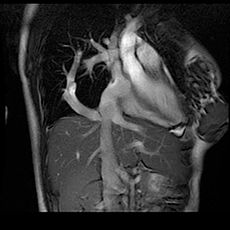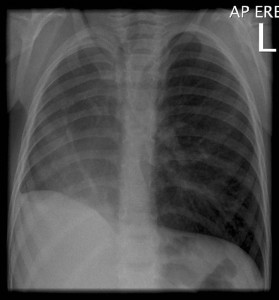Scimitar Syndrome is a condition that can occur as an innate disorder or may develop at a later age of an individual. Find out all about the causes, symptoms, treatment options and prognosis of the disease.
Scimitar Syndrome Definition
Page Contents
- 1 Scimitar Syndrome Definition
- 2 Scimitar Syndrome Synonyms
- 3 Scimitar Syndrome Incidence
- 4 Scimitar Syndrome Presentation
- 5 Scimitar Syndrome Causes
- 6 Scimitar Syndrome Signs and Symptoms
- 7 Scimitar Syndrome Prevention
- 8 Scimitar Syndrome Diagnosis
- 9 Scimitar Syndrome Differential Diagnosis
- 10 Scimitar Syndrome Treatment and Management
- 11 Scimitar Syndrome Prognosis
- 12 Scimitar Syndrome Complications
- 13 Scimitar Syndrome and Pregnancy
- 14 Scimitar Syndrome Life Expectancy
- 15 Scimitar Syndrome Images
It is a form of congenital heart disorder which occurs due an abnormal arrangement of pulmonary veins. This condition generally affects people in their early childhood and may be present in newborns. It can be genetically acquired during fetal development. The disease causes some or all the pulmonary veins to drain into the patient’s inferior vena cava. Associated anomalies of this disorder usually include hypoplasia of right lung, systemic arterial supply to right lung from the descending aorta, Dextrocardia and various congenital cardiac diseases like ASD.
When seen on x-ray, the abnormal vein bears resemblance to the shape of a scimitar (a curved sword) and this explains the unique name of the condition. Surgical intervention is generally required for repairing these abnormalities.
Scimitar Syndrome Synonyms
It is also referred to by the following names:
- Pulmonary Venolobar Syndrome
- Hypogenetic Lung Syndrome
- Mirror-Image Lung Syndrome
- Venacava Bronchovascular Syndrome
- Halasz’s Syndrome
- Epibronchial Right Pulmonary Artery Syndrome
Scimitar Syndrome Incidence
The incidence of this disease is around 1 to 3 in every 100,000 live births. However, the actual prevalence rate is likely to be higher because in many cases the patients remain asymptomatic for most of their lives. Females are more likely to develop the syndrome compared to males.
Scimitar Syndrome Presentation
In healthy people, the pulmonary vein carries the oxygenated blood to the left side of one’s heart. But in Pulmonary Venolobar Syndrome patients, there is an abnormal venous connection between the systemic venous circulation and pulmonary venous circulation. This connection creates an anomalous left-to-right shunt. These defects result in return of a significant amount of right pulmonary venous blood into the inferior vena cava of an individual.
Scimitar Syndrome Causes
The exact causes of this syndrome are still not known. It often occurs as a congenital disorder, which means that the patients are born with it. Hypogenetic Lung Syndrome may be a familial condition, affecting children with a family history of the abnormality. It is usually associated with certain hereditary factors.
Scimitar Syndrome Signs and Symptoms
The condition may sometimes be asymptomatic, which means it does not cause any symptoms in the patient and the patient remains unaware of its presence. But in serious cases, the disease leads to some serious health problems. Its common symptoms are mentioned below:
- Respiratory distress
- Rapid breathing
- Shortness of breath
- Cyanosis
- Retraction of the rib cage muscle
Scimitar Syndrome Prevention
There is no known way to prevent Hypogenetic Lung Syndrome as the underlying causes responsible for it are unknown. Couples with a family history of this type of heart disorder are more likely to have children with the condition compared to those with no such family history. Due to this reason, genetic counseling can help to determine the risks of having a child with the syndrome. In some cases, however, it can develop spontaneously in an individual at an early age. It is not possible to prevent the disorder in these cases.
Scimitar Syndrome Diagnosis
The diagnostic procedure of this disease may vary from one patient to another. A doctor may perform various tests and examinations to see if this disease is present in patients suffering from dizziness, chest pain, weakness and irregular heart beat. Various imaging and other tests are used for this purpose. These include:
- Chest x-ray
- Transesophageal or transthoracic echocardiography
- Angiography
- CT angiography
- MR Angiography
- MRI
An x-ray can help the doctor to detect the presence of this abnormality from its scimitar shape. Other signs that help with the diagnosis include right middle lobe atelectasis, pulmonary sequestration and unilateral absence of the pulmonary artery.
Prenatal diagnosis can be useful to gain the earliest knowledge of the condition. It allows doctors to start the treatment as early as possible.
Scimitar Syndrome Differential Diagnosis
During diagnosis, it is important to ensure that the symptoms are a result of Scimitar Syndrome and not that of the following conditions:
- Arteriovenous Malformation
- Intralobar Sequestration
- Mucoid Impaction or Bronchial Atresia
- Pulmonary Varix
- Pulmonary Sequestration
- Unilateral Absence of Pulmonary Artery or UAPA
- Right Middle Lobe Atelectasis
Scimitar Syndrome Treatment and Management
Asymptomatic patients do not generally require any treatment, but are kept under constant observation for any signs of deterioration. However, patients with evident symptoms need early and proper treatment to avoid serious complications. Surgical correction of the abnormality is the most common treatment option. There are various surgeries that can help in the management of the condition.
The principal object of surgery is to create an inter-atrial baffle for redirecting the pulmonary venous circulation into the patient’s left atrium. There is another surgical operation which involves re-implanting the abnormal vein directly into the patient’s left atrium. Patients suffering from pulmonary hypertension as an associated condition require surgical management. The form of treatment to be used is decided by the physician depending on the severity and nature of the symptoms as well as the associated disorders. It is also important to consider some other factors like the quantity of blood flow into the inferior vena cava and the degree of shunting of left to right.
Scimitar Syndrome Prognosis
The prognosis depends on the severity of the condition. Patients who do not have any associated disorders generally have a positive outcome with proper treatment. In other cases, the prognosis depends on the associated congenital disorders present in the patient. However, early diagnosis and timely treatment allows a patient to have a relatively long and healthy life.
Scimitar Syndrome Complications
One of the most serious potential complications of this disorder is the development of pulmonary hypertension. Pulmonary Venolobar Syndrome can even cause death of a patient if not treated properly.
Scimitar Syndrome and Pregnancy
Women suffering from Pulmonary Venolobar Syndrome may not be able to get pregnant because of the abnormal pulmonary vein arrangement. However, studies show that in some cases the patients have successfully carried and given birth to healthy babies.
Scimitar Syndrome Life Expectancy
Children diagnosed with this syndrome during the first year of their lives are likely to have a poor life expectancy. However, various case reports show that the patients can live a comparatively long life and reach an advanced age with proper treatment. In most cases, however, patients have a short life span. The mortality rate is relatively lower when the disorder develops in adults.
Scimitar Syndrome Images
The following pictures will help you understand how this abnormality is presented on the imaging test reports.
Picture 1 – Scimitar Syndrome
Picture 2 – Scimitar Syndrome Image
Scimitar Syndrome is a rare cardiac disorder that can turn fatal if not treated properly. Many individuals suffering from the condition are allowed to live a long and normal life with early and appropriate surgical treatment. There are various forums and support groups who provide guidelines for the patients and their families about how to best cope with the disorder.
References:
http://www.heart-consult.com/articles/scimitar-syndrome
http://www.wisegeek.com/what-is-scimitar-syndrome.htm
http://radiopaedia.org/articles/scimitar_syndrome
http://medical-dictionary.thefreedictionary.com/Scimitar+Syndrome
http://www.vcuthoracicimaging.com/Historyanswer.aspx?qid=74&fid=1


